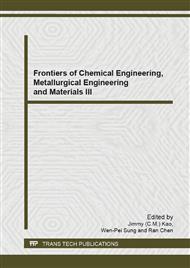[1]
A.N. Dodd, J. Kudla, D Sanders, The language of calcium signaling, Annu Rev Plant Biol. 61(2010): 593-620.
DOI: 10.1146/annurev-arplant-070109-104628
Google Scholar
[2]
J. Groenendyk, J. Lynch, M. Michalak. Calreticulin, Ca2+, and calcineurin-signaling from the endoplasmic reticulum, Mol Cells. 17 (2004)383-389.
Google Scholar
[3]
D. Sanders, J. Pelloux, C. Brownlee, J.F. Harper, Calcium at the crossroads of signaling. Plant Cell. 14(2002): S401-S417.
DOI: 10.1105/tpc.002899
Google Scholar
[4]
J. Kudla, O. Batistic, K. Hashimoto, Calcium signals: the lead currency of plant information processing. Plant Cell. 22(2010): 541-563.
DOI: 10.1105/tpc.109.072686
Google Scholar
[5]
J. Liu, M. Ishitani, U. Halfter, C.S. Kim, J.K. Zhu, The Arabidopsis thaliana SOS2 gene encodes a protein kinase that is required for salt tolerance, Proc Natl Acad Sci USA. 97(2000): 3730-3734.
DOI: 10.1073/pnas.97.7.3730
Google Scholar
[6]
U. Halfter, M. Ishitani, J.K. Zhu, The Arabidopsis SOS2 protein kinase physically interacts with and is activated by the calcium-binding protein SOS3, Proc Natl Acad Sci USA. 97(2000): 3735-3740.
DOI: 10.1073/pnas.97.7.3735
Google Scholar
[7]
H. Shi, M. Ishitani, C. Kim, J.K. Zhu, The Arabidopsis thaliana salt tolerance gene SOS1 encodes a putative Na+/H+ antiporter, Proc Natl Acad Sci USA. 97(2000): 6896-6901.
DOI: 10.1073/pnas.120170197
Google Scholar
[8]
D. Gong, Y. Guo, A.T. Jagendorf, J.K. Zhu, Biochemical characterization of the Arabidopsis protein kinase SOS2 that functions in salt tolerance, Plant Physiol. 130(2002): 256-264.
DOI: 10.1104/pp.004507
Google Scholar
[9]
M.J. Sánchez-Barrena, M. Martínez-Ripoll, J.K. Zhu, A. Albert, The structure of the Arabidopsis thaliana SOS3: molecular mechanism of sensing calcium for salt stress response, J Mol Biol. 345 (2005): 1253-1264.
DOI: 10.1016/j.jmb.2004.11.025
Google Scholar
[10]
B.G. Kim, R. Waadt, Y.H. Cheong, G.K. Pandey, J.R. Dominguez-Solis, S. Schultke, S.C. Lee, J. Kudla, S. Luan, The calcium sensor CBL10 mediates salt tolerance by regulating ion homeostasis in Arabidopsis, Plant J. 52(2007): 473-484.
DOI: 10.1111/j.1365-313x.2007.03249.x
Google Scholar
[11]
J. Xu, H.D. Li, L.Q. Chen, Y. Wang, L.L. Liu, L. He, W.H. Wu, A protein kinase, interacting with two calcineurin B-like proteins, regulates K+ transporter AKT1 in Arabidopsis, Cell. 125(2006): 1347-1360.
DOI: 10.1016/j.cell.2006.06.011
Google Scholar
[12]
C.D. Angelo, S. Weinl, O. Batistic, G.K. Pandey, Y.H. Cheong, S. Schultke, V. Albrecht, B. Ehlert, B. Schulz, K. Harter, S. Luan, R. Bock, J. Kudla, Alternative complex formation of the Ca2+-regulated protein kinase CIPK1 controls abscisic acid-dependent and independent stress responses in Arabidopsis, Plant J. 48:(2006).
DOI: 10.1111/j.1365-313x.2006.02921.x
Google Scholar
[13]
V. Tripathi, B. Parasuraman, A. Laxmi, D. Chattopadhyay, CIPK6, a CBL- interacting protein is required for development and salt tolerance in plants. Plant J. 58 (5) (2009): 778-790.
DOI: 10.1111/j.1365-313x.2009.03812.x
Google Scholar
[14]
H.L. Piao, Y.H. Xuan, S.H. Park, B. Je, S.J. Park, S.H. Park, C.M. Kim, J. Huang, G.K. Wang, M.J. Kim, S.M. Kang, I.J. Lee, T.R. Kwon, Y.H. Kim, U.S. Yeo, G. Yi, D.Y. Son, C.D. Han, OsCIPK31, a CBL-interacting protein kinase is involved in germination and seedling growth under abiotic stress conditions in rice plants. Mol. Cells. 30 (2010).
DOI: 10.1007/s10059-010-0084-1
Google Scholar
[15]
C.L. Huang, S. Ding, H. Zhang, H. Du, L.Z. An, CIPK7 is involved in cold response by interacting with CBL1 in Arabidopsis thaliana. Plant Sci. 181(2011): 57-64.
DOI: 10.1016/j.plantsci.2011.03.011
Google Scholar
[16]
S. Luan, J. Kudla, M. Rodriguez-Concepcion, S. Yalovsky, W. Gruissem, Calmodulins and calcineurin B-like proteins: calcium sensors for specific signal response coupling in plants. Plant Cell. 14(2002, ): S389-S400.
DOI: 10.1105/tpc.001115
Google Scholar
[17]
J. Kudla, Q. Xu, K. Harter, W. Gruissem, S, Luan. Genes for calcineurin B-like proteins in Arabidopsis are differentially regulated by stress signals. Proc Natl Acad Sci USA. 96(1999): 4718-4723.
DOI: 10.1073/pnas.96.8.4718
Google Scholar
[18]
J. Liu, J. K Zhu. A, calcium sensor homolog required for plant salt tolerance. Science. 280(1998): 1943-(1945).
DOI: 10.1126/science.280.5371.1943
Google Scholar
[19]
D. Gong, Y. Guo, A.T. Jagendorf, J.K. Zhu. Biochemical characterization of the Arabidopsis protein kinase SOS2 that functions in salt tolerance. Plant physiol. 130(2002): 256-264.
DOI: 10.1104/pp.004507
Google Scholar
[20]
V. Albrecht, O. Ritz, S. Linder, K. Harter, J. Kudla, The NAF domain defines a novel protein-protein interaction module conserved in Ca2+-regulated kinases. EMBO J. 20(2001): 1051-1063.
DOI: 10.1093/emboj/20.5.1051
Google Scholar
[21]
B. Ramani, T. Reeck, A. Debez, R. Stelzer, B. Huchzermeyer, A. Schmidt, J. Papenbrock. Aster tripolium L. and Sesuvium portulacastrum L.: two halophytes, two strategies to survive in saline habitats. Plant Physiology and Biochemistry. 44(2006).
DOI: 10.1016/j.plaphy.2006.06.007
Google Scholar
[22]
H.C. Hu, Y.Y. Wang, Y.F. Tsay. AtCIPK8, a CBL-interacting protein kinase, regulates the low-affinity phase of the primary nitrate response. Plant J. 57(2009): 264-278.
DOI: 10.1111/j.1365-313x.2008.03685.x
Google Scholar


